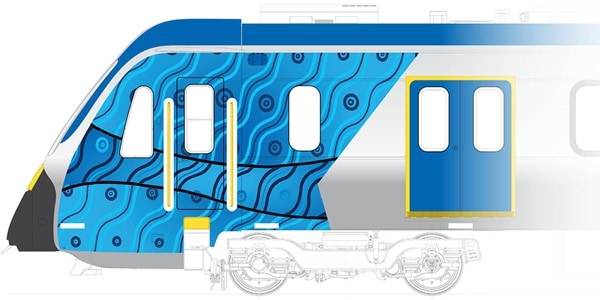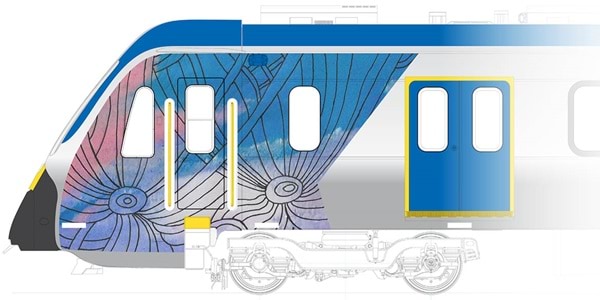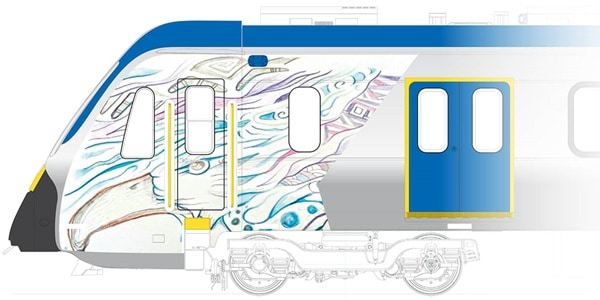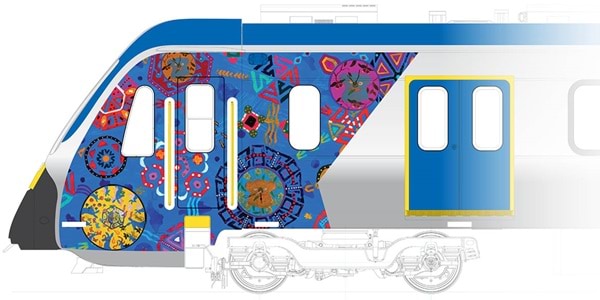Wurundjeri woman Mandy Nicholson was awarded an $18,000 Victorian Government creative commission as the selected artist for the project.
Ms Nicholson is a Traditional Custodian of Narrm (Melbourne). She also has Dja Dja Wurrung and Ngurai Illum Wurrung heritage, all forming part of the Eastern/Central Kulin Nation of Victoria.
Her winning design, ‘Wurundjeri Biik (Wurundjeri Country)’, explores the Wurundjeri culture’s connection to Country and our shared journey.
The work will help passengers better understand and appreciate the first culture of Melbourne as they go about their commute.
The winning artwork was selected from a pool of four shortlisted artists and collectives, including:
- Wurundjeri woman Mandy Nicholson (Hampton Park)
- Kirrae Whurrong woman Fiona Clarke (Warrnambool)
- Boon Wurrung man Adam Magennis (Mornington)
- Ballarat-based mob of three Koori men, Pitcha Makin Fellas, who belong to different language groups.
Their work is generous. It shares and celebrates Indigenous perspectives on the shared journeys we make through our city and reminds us just how long people have been travelling across this land.
Here’s what our shortlisted artists have to say about their designs.
Mandy Nicholson (selected artist)
Wurundjeri culture has many different elements that make up the whole. These are physical or tangible elements of culture, such as language (Woiwurrung), dance, animals, and the environment, and within those are the intangible or spiritual elements.
These include the six layers of Country:
- 'Biik-ut (Below Country): Where we collect ochre for dance and ceremony.
- Biik-dui (On Country): Where we do those ceremonies and dances.
- Baanj Biik (Water Country): Water forms part of our Welcoming ceremonies as well as it being in every layer of Country as a life source.
- Murnmut Biik (Wind Country): The wind carries our language and smoke from our Welcome fire up to Bunjil and absorbs into everything around us.
- Wurru Wurru Biik (Sky Country): Where we see Bunjil in his physical form.
- Tharangalk Biik (Star Country): Where Bunjil lives in his spiritual form as the star Altair.’
These layers are all intrinsically linked and cannot survive without the other. These ancient connections are relevant to all that now call Narrm (Melbourne) home. In my design, the train carriages depict different layers of Country and the theme of ‘journey’.
Highlighting these layers of Wurundjeri Country shines a light on a culture that is almost hidden in the urban context. It will help people understand that spiritual connection has always been and will continue as we all travel our shared path.
Watch an interview with Mandy Nicholson talking about her design.
Fiona Clarke
Fiona’s work features symbols of Melbourne landmarks and important meeting places, including the MCG, the Yarra/Birrarung River, the City Loop and train stations, and Federation Square.
“The overall aim is to pull all the important things about Melbourne into the centre and to connect all the things that make Melbourne a great community while acknowledging and sharing our First Peoples' culture and history.”
Kaptify (Adam Magennis)
Our creative work aims to symbolise and celebrate the diversity of the Kulin Nation cultures within the metropolitan Melbourne train network.
The illustrative designs showcase the diverse cultural landscapes of the Kulin Nations - Woiwurrung, Dja Djawurrung, Taungwurrung, Wadawurrung and Boonwurrung language group areas - and recognised cultural elements of these Kulin Nation cultures.
We have undertaken preliminary consultation with individual Kulin Nation community members to identify cultural symbols, natural shapes and patterns which will feature on the train livery design.
We have also conducted preliminary research about Kulin Nations in appropriately qualified internet search engines. Further consultation is required with Registered Aboriginal Parties if awarded the project.
Bunjil and Waa (Creator) will be on the front and rear ends of the train carriages, with individual carriage designs representing each Kulin Nation member.
The illustration includes the topography from spiritual mountain ranges of the Kulin. Plants, animals, insects and geology will also be included on each carriage design.
Pitcha Makin Fellas
Pitcha Makin Fellas have been interested in ‘time’ for some time. We are all time-poor it seems, running to work and then somewhere else in a hurry. Blackfella Time tells a different story.
For the livery design, a selection of clocks will be integrated into the background image, ‘More Than One Golden Nation’.
One clock might have the six seasons of the Gunditjmara all over its face and just a sweep second hand. Another clock might go from 1 to 60,000 to remind us how long Aboriginal people have been here.
'More than One Golden Nation’ is a sparkling picture representing some of the 300 Nations that made this country and how they connected. It tells us that Aboriginal people were here before gold was discovered, were present on the goldfields, and are still here now. It reminds us of the wisdom, resilience and creative strength of Aboriginal people and their generosity of spirit.
Updated



